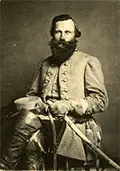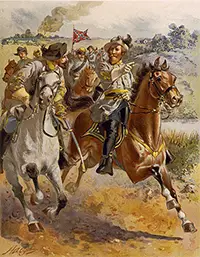J.E.B. Stuart: Confederate Cavalry Commander
J.E.B. Stuart was a well-known cavalry commander for the Confederate Army during the American Civil War. He was born on Feb. 6, 1833, at Laurel Hill Farm, in Patrick County, Va. Having left home when he was 12, he attended school in Wytheville and then, when he was 15, attended Emory and Henry College. 
He enrolled in the U.S. Military Academy in 1850 and graduated four years later. A brilliant student, he was exceedingly gifted as a horseback rider. His first assignment after leaving West Point, with the rank of second lieutenant, was with the Regiment of Mounted Rifles in Texas. He joined the 1st U.S. Cavalry on March 3, 1855, at Fort Leavenworth, in the Kansas Territory. Later that year, he married Flora Cooke; they had three children. Stuart was a volunteer aide to Robert E. Lee when the latter was tasked with capturing the abolitionist John Brown, who had seized the federal arsenal at Harpers Ferry. It was Stuart, under a flag of truce, who tried to negotiate Brown's surrender. The Army promoted Stuart to the rank of captain on April 22, 1861. However, Confederate troops had fired on Fort Sumter 10 days before and, when Virginia joined a handful of other Southern states in seceding from the Union, Stuart resigned his commission, on May 14. He joined the Confederate army with the rank of colonel, and his first assignment was as commander of the 1st Virginia Cavalry, serving under Gen. Joseph Johnston in the Army of the Valley. One of his first significant feats was to distract a Union army long enough for Johnston to get free of the Shenandoah Valley and end up at Manassas, in time for the First Battle of Bull Run/Manassas. Stuart and his cavalry made it in time for that battle as well and were instrumental in driving Irvin McDowell's Union army from the field of battle. Stuart won promotion to brigadier general after the victory. 
Following that, Stuart and his troops rode entirely around Gen. George McClellan's Army of the Potomac and then returned to report to Lee, enabling the latter to have a greater grasp of the size of the Union army and the scope of the task ahead. Lee counterattacked in a series of battles that eventually convinced McClellan to abandon his Peninsula Campaign and retreat north. Stuart won a promotion to major general and overall command of the cavalry division of the Army of Northern Virginia. In that capacity, he streamed through the Union ranks during the Second Battle of Bull Run/Manassas, ransacking the headquarters of Union commander John Pope and stealing his dress uniform. Stuart also played a vital role in preventing a large number of Union troops from reaching Sharpsburg for what would eventually be a showdown between Lee and McClellan. At the resulting Battle of Antietam/Sharpsburg, Stuart and his cavalry executed a second ride around the Union forces. Continuing his string of highly consequential feats, Stuart and his men provided Lee with prime intelligence in the opening stages of the Battle of Chancellorsville, enabling the Confederate troops to strengthen their position and, ultimately, convince Union commander Joseph Hooker to retreat from what should have been an advantageous position. Just weeks before, Stuart and his cavalry had also played a vital role in protecting the flank of Stonewall Jackson's troops at Fredericksburg. In June 1863, Stuart and his force captured 125 Union supply wagons near Rockville, Md. Rather than burn them, he decided to bring them back with him in a move back to join Lee's army, which had invaded the North for a second time. Stuart and his prized reconnaissance elements did not arrive at the Battle of Gettysburg until it was too late. Earlier that month, Stuart had fought in the Battle of Brandy Station, the largest cavalry engagement of the war. He had set out to protect Lee's advance into Pennsylvania and narrowly defeated a Union combined cavalry and infantry attack. The growing occupation by Union forces of western Virginia and large swathes of the West made it more and more difficult for Stuart and his cavalry to be effective at being the "eyes and ears" of the Confederate army. Stuart did have one more successful endeavor, in the spring of 1864. On May 7, after the unearthly devastating Battle of the Wilderness, the Union's top commander, Ulysses S. Grant, chose not to retreat but to march onward, toward Richmond, the capital of the Confederacy. Grant and his men streamed around the flank of the Confederate army, leaving Lee a step too slow. Stuart, however, was able to get cavalry to Spotsylvania Court House in time to block the Union advance until Lee's main force could arrive. Stuart and the Union's top cavalry commander, Philip Sheridan clashed on May 11 at Yellow Tavern; and Stuart, outnumbered 2–1, led his men to victory. He was mortally wounded in the fighting and died a day later; he was 31. |
|
Social Studies for Kids
copyright 2002–2024
David White




